Swordfish dwell in the deep parts of the sea. Their staggering size makes it incredibly challenging to fathom being close to them. Interacting with humans is an exceedingly uncommon event for these creatures, and such occurrences have generally been primarily devoid of harm.
From the adrenaline-pumping catch to the astonishing measurements of this fish, get ready to be captivated by the awe-inspiring feat accomplished by a skilled angler in California’s abundant waters. Here’s a clue: the fish surpassed 400 pounds in weight!
About Swordfish
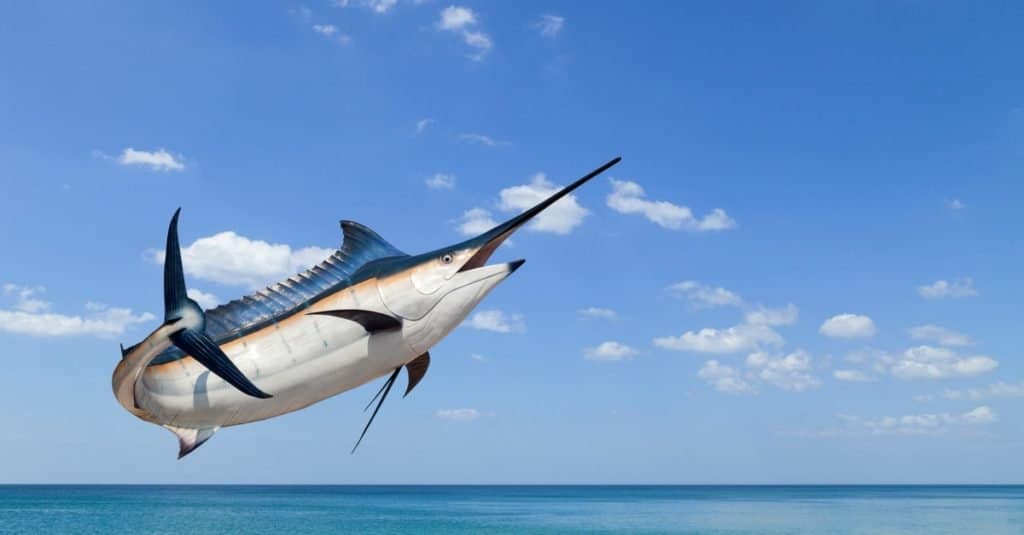
With its long, agile body, the swordfish is a master of the open ocean.
©Stock High angle view/Shutterstock.com
The swordfish (Xiphias gladius) holds a special status in the fish world, cherished for its culinary allure and as game fish. It is considered the sole representative of the Xiphiidae family. You can encounter it in warm and tranquil seas across the planet.
Swordfish possess a prominent tall dorsal fin characterized by its elongated body and absence of scales. Unlike marlins and other species with spear-shaped noses, the sword of a swordfish is flat, earning it the alternative moniker of broadbill. The lack of pelvic fins and teeth sets the swordfish apart.
Size and Appearance
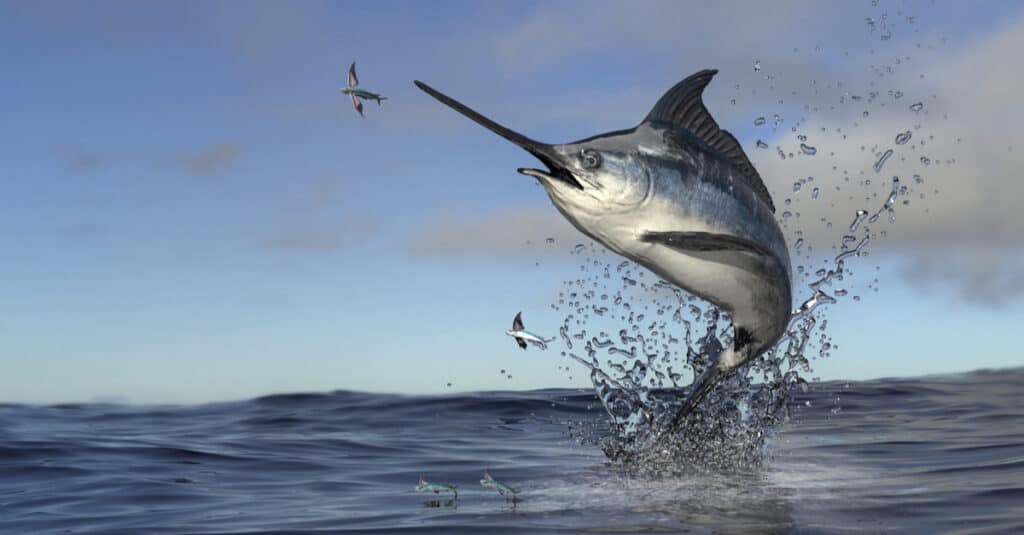
Swordfish are large, highly migratory predatory fish characterized by a long, flat, pointed bill.
©bekirevren/Shutterstock.com
Swordfish have a robust physique, characterized by a rounded body and wide eyes. The initial dorsal fin on its back stands tall, assuming a crescent shape. In contrast, the second dorsal fin is considerably tiny.
Their anal fins, found on the belly region, mirror the shape of the dorsal fins, albeit smaller. A comprehensive, crescent-shaped tail completes its distinctive form. Their coloration exhibits a gradient, with the darkest hues predominantly adorning the uppermost part, presenting as black or brown and progressively transitioning to lighter shades beneath.
Swordfish typically measure around 9 feet long, although some can reach 15 feet. Their weight averages around 400 pounds, yet the record-breaking swordfish ever captured weighed 1,182 pounds.
Habitat and Distribution
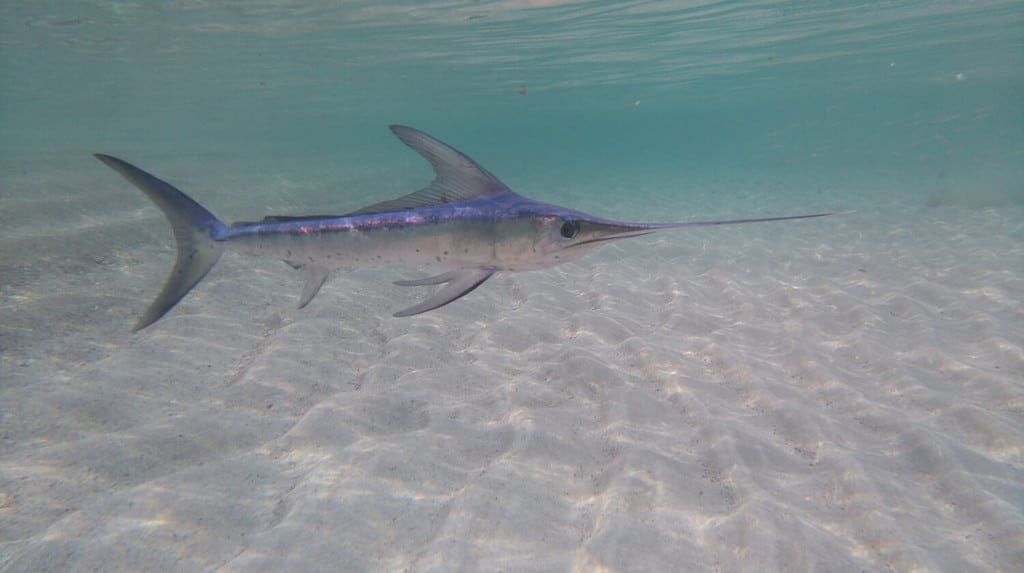
The open ocean is the primary habitat for swordfish, where they can hunt for prey and avoid predators.
©SVITO-Time/Shutterstock.com
Swordfish are present in oceans worldwide, regardless of whether the water is warm or cold. However, they favor warmer temperatures ranging from 64 to 72 °F. Their migratory nature is remarkable as they navigate toward warmer regions during winter and seek out cooler waters in the summer.
Their prime reproduction time is between April and September. They inhabit the ocean’s depths at a staggering 1500 feet. Apart from humans and the occasional orca, adult swordfish encounter minimal threats from predators. Juvenile swordfish face heightened vulnerability to predation and serve as prey for a diverse array of predatory fish.
North Atlantic Swordfish undertake extensive annual migrations along the eastern coast of the United States and Canada, spanning thousands of miles. They’re present throughout the year in the Caribbean, the Gulf of Mexico, and Florida.
These nomadic fish, inhabiting the middle layers of the ocean (mesopelagic zone), are also distributed across the Atlantic and Mediterranean seas. Prime fishing locations for swordfish include the Florida Keys, Virginia Beach, Southern California, and Islamorada in Florida.
Swordfish and Human Interaction

©Derke Snodgrass, NOAA/NMFS/SEFSC/SFD / Public Domain – Original / License
Throughout history, people have pursued swordfish through a myriad of fishing techniques. In the past, the conventional approach involved harpooning, resulting in arduous and prolonged battles.
The emergence of long-line fishing, employing extended lines equipped with numerous hooks, significantly disrupted their numbers. The swordfish population experienced a substantial impact, prompting stringent regulations to safeguard their sustainability in commercial fisheries. Swordfish can present a considerable hazard when pursued with harpoons. However, there have been no reports of unprovoked attacks on individuals.
Accounts suggest that these creatures are known for impaling their blades through the wooden hulls of smaller boats in instances where they have sustained injuries. A tragic incident occurred in 2015 when a fisherman from Hawaii tragically perished while trying to kill a swordfish using a spear.
Climate Change and Global Warming
Climate change has harmed the swordfish, leading to a shrinking of their habitat. These large creatures heavily rely on an abundant oxygen supply for their survival. Unfortunately, the expanding dead zones in the ocean have decreased oxygen levels, transforming specific areas into dead zones.
Consequently, the swordfish population has declined due to reduced suitable habitats. As oxygen becomes scarce, these animals struggle to breathe, facing conditions similar to the hypoxia in their natural environment.
Largest Swordfish Ever Caught in California

A giant swordfish weighing 452 pounds and 8 ounces holds the title for the biggest ever caught in the waters of California. David M. Denholm achieved this extraordinary feat during a fishing expedition near Catalina Island. The record-breaking moment occurred on September 30, 2003, within the boundaries of Los Angeles County. Denholm was an avid sport fisher and member of the Tuna Club who had travelled the world with other well-known big-game fishers looking for a great catch.
The Biggest Swordfish Ever Caught
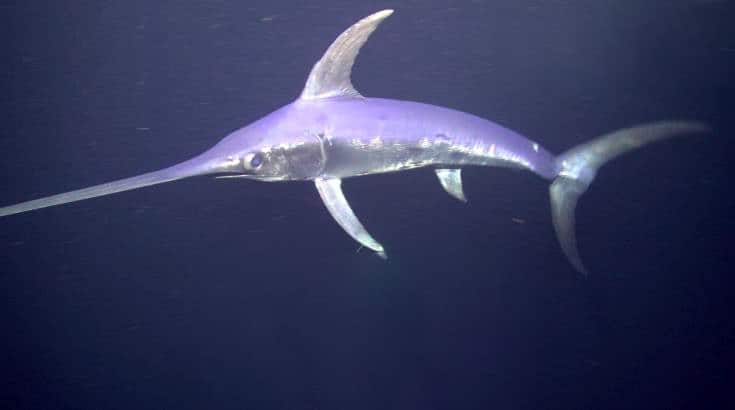
© NOAA Deep Sea Coral Research & Technology Program-Pelagic Research Services / Public Domain – Original / License
The International Game Fish Association (IGFA) states that a colossal swordfish weighing 1,182 pounds is the largest documented. This record-breaking behemoth was captured in Iquique, Chile, on May 7, 1953. Louis E. Marron was fishing with his wife, Genie, on Flying Heart III, skippered by Captain Eddie Wall. In just two hours, after the giant fish struck a trolled bonito, he reeled in the largest swordfish caught on record: a 1,182-pound swordfish. To catch this gigantic fish, he used a Black Palm rod and 12/0 Fin-Nor Reel with a 39-thread Cortland Super Cutty line. More than six decades later and it’s still the IGFA All-Tackle World Record.
What Do Swordfish Eat?

©iStock.com/FtLaudGirl
A recent publication in the Bulletin of Marine Science sheds light on swordfish’s primary diet, which consists mainly of cephalopods. Surprisingly, they also partake in fish and shellfish for sustenance. Swordfish lack teeth, compelling them to swallow their prey entirely. This unique feeding behavior restricts the size of the game they can devour.
Here is a list of food that swordfish consume:
- Jumbo squid
- Northern anchovy
- Market squid
- Cuttlefish
- Octopus
- Shellfish
- Hake
- Mackerel
- Bluefish
- Oceanic Puffer
- Herring
What Do Baby Swordfish Consume?

Plankton are organisms drifting in oceans and seas. Zooplankton.
©tonaquatic/iStock via Getty Images
These swordfish begin as larvae. Despite their microscopic proportions compared to their adult counterparts, these nascent swordfish possess a discernible bill from birth. The food of choice for these infant swordfish consists of tiny zooplankton.
The Ideal Season for Swordfish Fishing

©Gema Alvarez Fernandez/Shutterstock.com
California summers offer optimal conditions for thrilling deep-sea fishing adventures. The warmer water temperatures during this season stimulate heightened fish activity. Moreover, the migratory patterns of various offshore fish species bring swordfish and other predators closer to the shoreline, making them more accessible from your boat.
The period from June to September, and occasionally extending to October, presents an exceptional opportunity for bountiful fishing expeditions in the deeper sections of the sea. Northern California also boasts impressive fishing prospects, particularly in San Francisco Bay and the Pacifica Pier. Familiar and exotic deep-water fish species can be found in abundance here.
Best Time to Catch Swordfish

©Wirestock/iStock via Getty Images
When seeking to capture swordfish, two options exist — daytime or nighttime. Each approach has distinct advantages and drawbacks. You may prefer pursuing swordfish during the day if you enjoy adrenaline rushes. Those who desire a calmer and more fruitful experience might favor casting their lines at night instead. Ultimately, there exists no single correct choice.
How to Catch Swordfish
Trolling or Drifting Methods
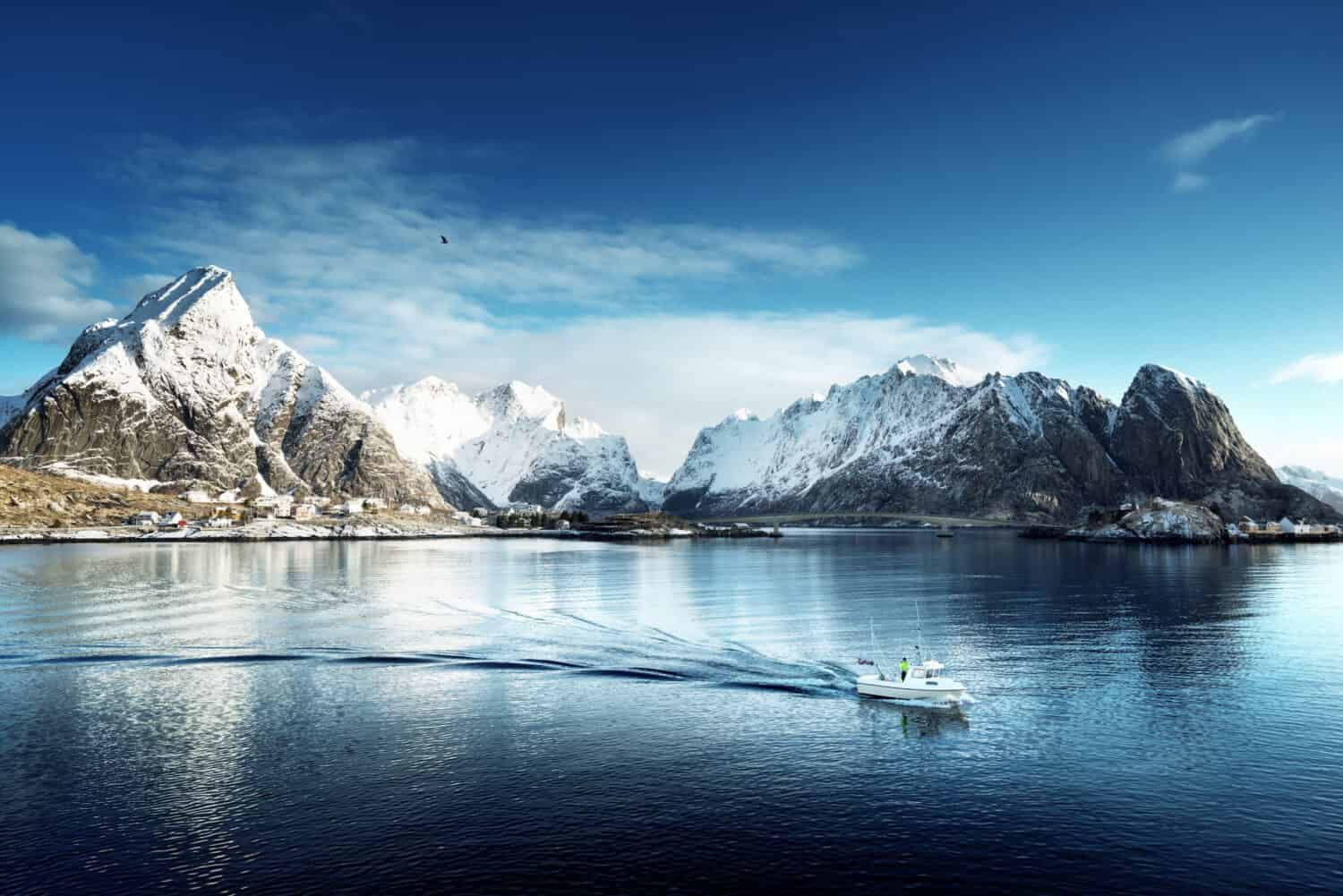
Two ways to fish for swordfish at night include trolling and drifting.
©ESB Professional/Shutterstock.com
Two ways to fish for swordfish at night include trolling and drifting. Trolling involves moving the boat slowly and steadily through the water. Drifting allows the boat to float with the wind and currents.
Trolling Method
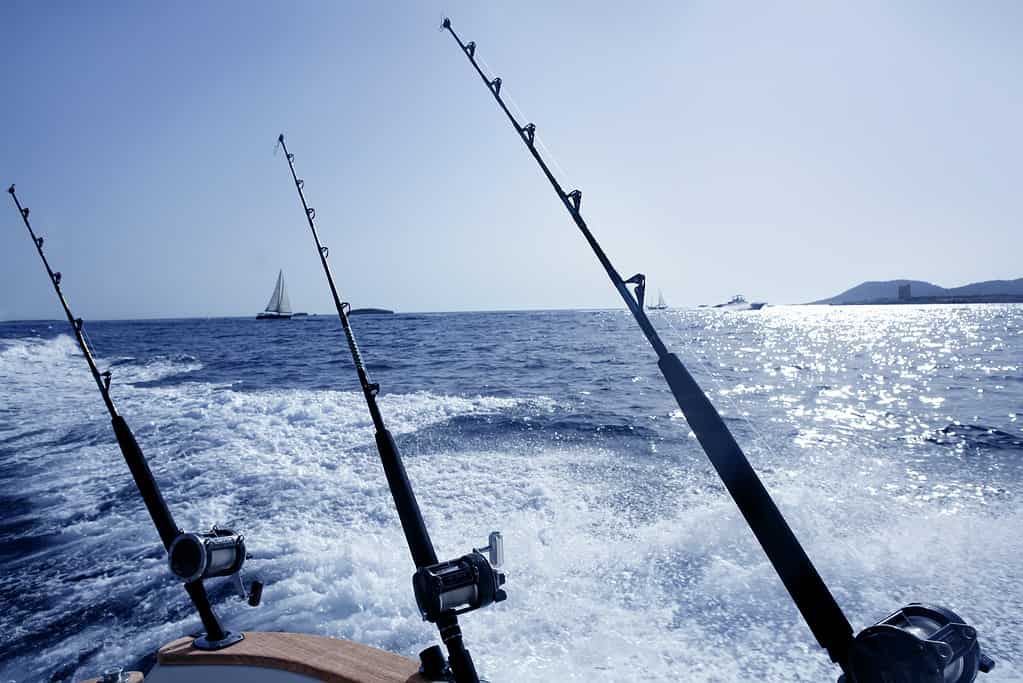
Boat trolling fishing on Mediterranean Ibiza Balearic Islands
©LUNAMARINA/iStock via Getty Images
To troll a swordfish, you need a heavy rod, a strong fishing leader, a large hook (9/0 or bigger), and bait like squid, mackerel, or mullet. Attach the bait to a light stick or strobe to attract their attention in the dark. Rig the bait with a breakaway weight for sinking.
The bait’s depth depends on water temperature, current, and moon phase. Warmer water, stronger current, and brighter moon mean swordfish feed closer to the surface. Start with one bait near the surface (around 50 feet), one in the middle (around 150 feet), and one near the bottom (approximately 300 feet). Stagger the baits at different distances from the boat to avoid tangling. Troll the boat along areas where swordfish gather, such as:
- Drop-offs
- Ledges
- Canyons
- Seamounts
Use the zigzag pattern to steer the boat for more coverage, noise, and vibration. Adjust the boat speed based on sea conditions and fish reaction. Slow down or stop if a swordfish strikes, allowing it to swallow the bait before setting the hook.
Drifting Method
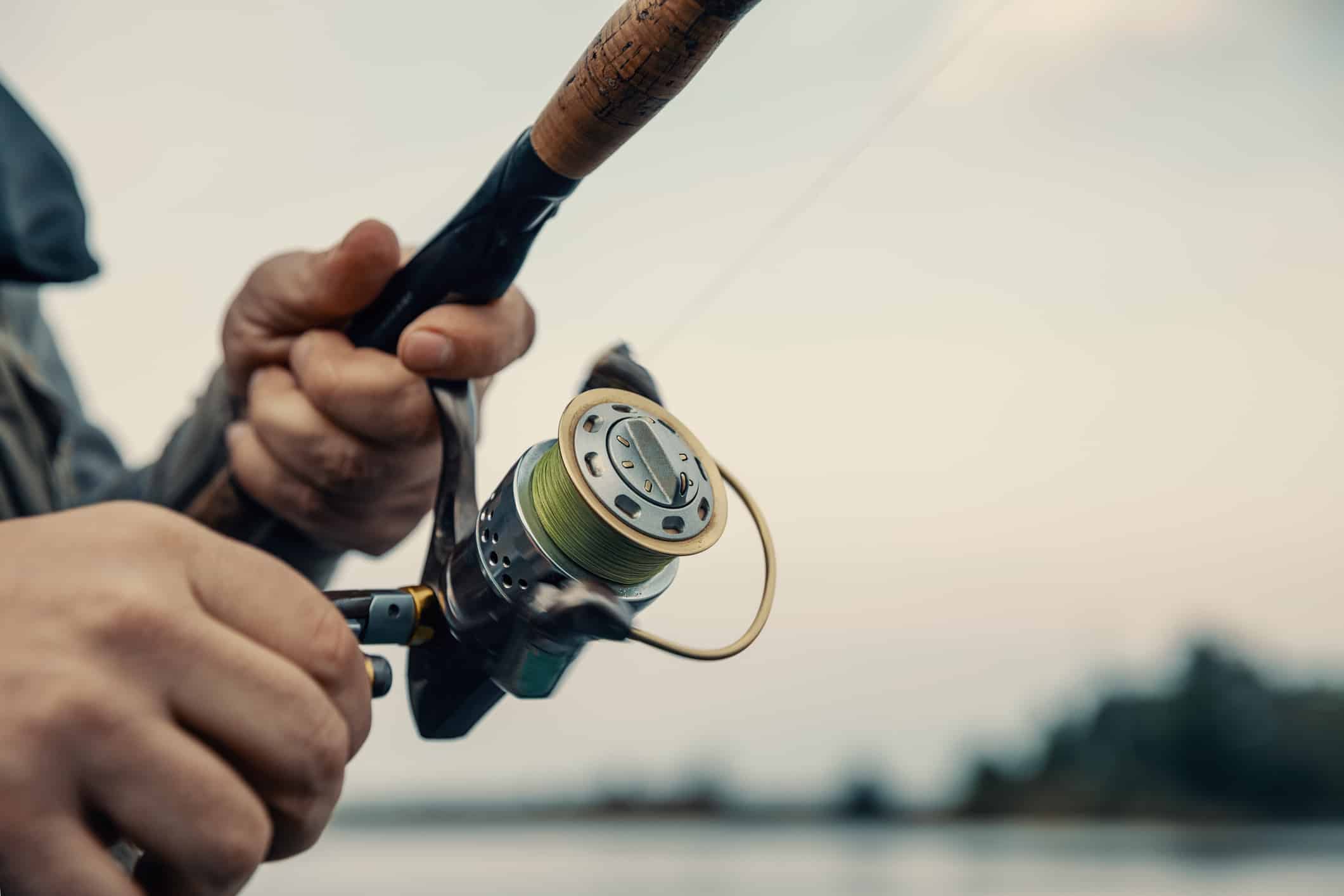
Fishing rod with a spinning reel in the hands of a fisherman.
©iStock.com/smiltena
Drifting for swordfish requires similar equipment and bait but with some adjustments. Opt for a lighter and more sensitive rod and reel for drifting. Use a longer leader (at least 50 feet) and a thinner one (around 150-pound test) to decrease visibility and increase flexibility. Use a smaller, sharper hook (7/0 or 8/0) for better hook-up success. Rig the bait with a balloon or float to maintain the desired depth.
Raise or lower the baits by adding or removing weight, or adjust by reeling in or letting out the line. Move the baits closer or farther from the boat by altering the fishing leader’s length or using a planer board. Drift the boat in areas where swordfish are likely to feed, as mentioned earlier. Drift perpendicular to the current or wind to cover more ground without spooking the fish. Control the drift speed by using a sea anchor or drogue.
When a swordfish bites, engage the boat’s gears and move away from the fish to create tension on the line and set the hook. Fight the fish with steady pressure and smooth movements, avoiding sudden jerks or pumps that could dislodge the hook.
Another Effective Method: Saltwater Trolling
Saltwater trolling is a highly effective technique for catching swordfish. You increase your chances of success by dragging enticing lures behind a moving boat — mimicking their natural prey. These lures can have hooks, lights, skirts, or other enticing accessories.
Saltwater trolling offers numerous advantages, including:
- It allows you to cover vast areas of water, facilitating fish location.
- It triggers the predatory instincts of swordfish, making them more inclined to strike.
- It minimizes the risk of losing the fish due to tangled or slack lines.
Nevertheless, saltwater trolling demands skill and preparation. Select suitable lures, rods, reels, lines, and leaders. Consider the prevailing conditions and the targeted fish’s size. Additionally, you must adjust trolling speed, depth, and direction based on the current, wind, and water temperature. Remaining alert and prepared to set the hook and fight upon detecting a bite is essential.
What Does Swordfish Taste Like?
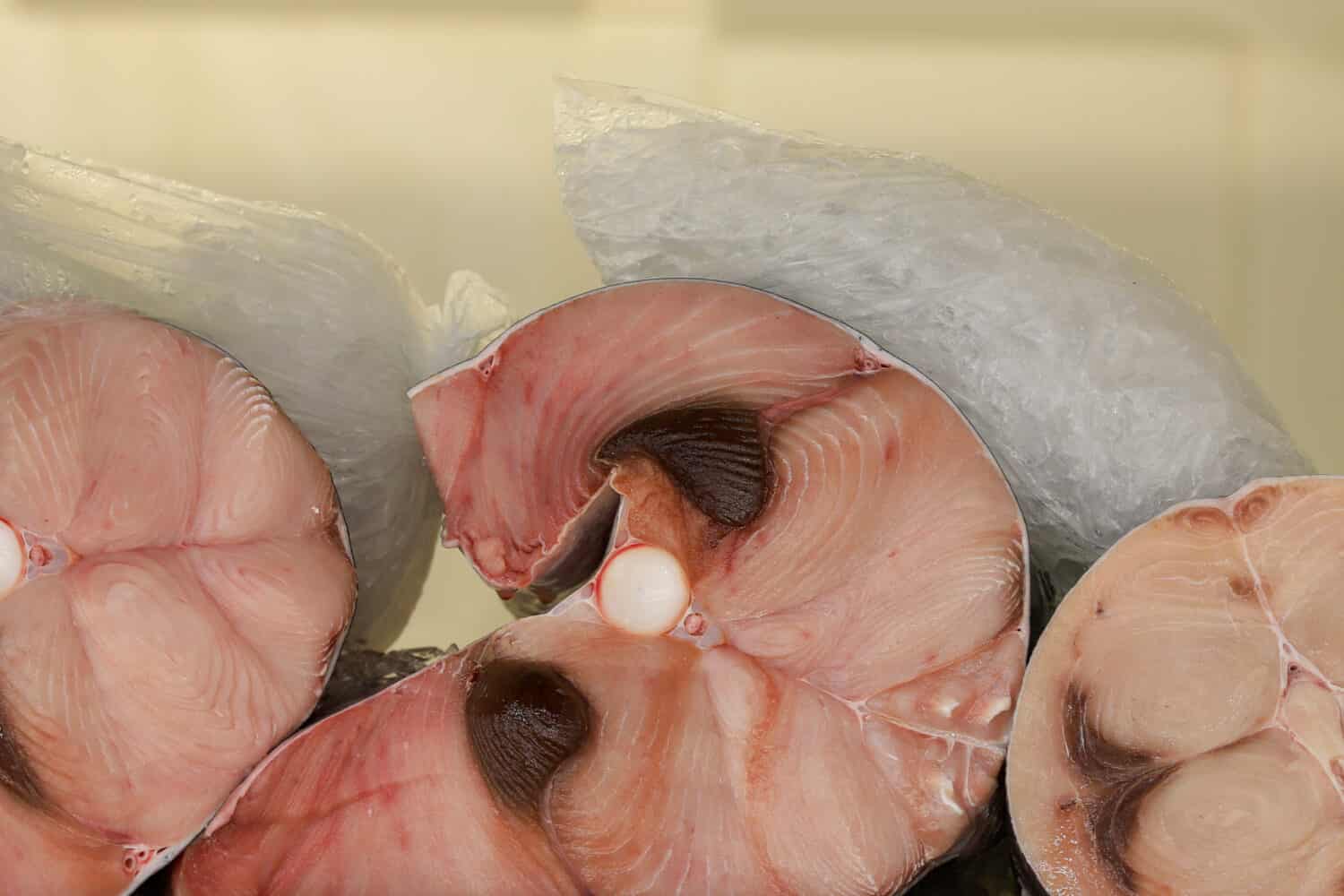
The swordfish species are known for their delicate and mild taste profile, exhibiting a tender sweetness.
©Structured Vision/Shutterstock.com
The swordfish species are known for their delicate and mild taste profile, exhibiting a tender sweetness. When uncooked, the hue of its meat appears white or has a pinkish-orange tint; however, it alters to a beige shade once it undergoes cooking. Its consistency is compact and rich in moisture, often compared to the texture of a beef cut. This mild seafood is ideal for individuals inexperienced in fish consumption and those who don’t prefer more pungent fish tastes.
Are There Any Health Considerations When Consuming Swordfish?

©Prokrida/Shutterstock.com
Swordfish, being big fish, have higher mercury levels than other fish. Although the advantages of consuming fish surpass the mercury-related risks, it is possible to experience mercury poisoning from eating swordfish. Optimal health is achieved by consuming cooked swordfish, as cooking can decrease mercury content by around 30%.
Are Swordfish Endangered?
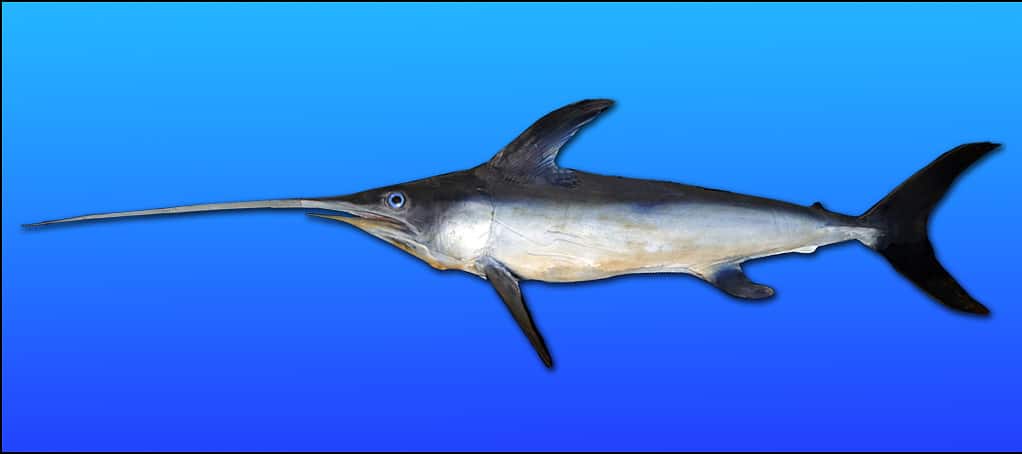
The swordfish population in the United States has faced numerous challenges over the years, prompting the implementation of various laws aimed at its recovery. Despite these efforts, positive outcomes took considerable time to materialize. Decades have passed since the initial measures were taken to safeguard swordfish from disappearing altogether. However, the question remains: Are swordfish still under the threat of extinction?
The swordfish population is no longer at risk. In 2021, the IUCN Red List categorized the global and Mediterranean swordfish (Xiphias gladius) as Near Threatened.
Interesting Facts about Swordfish

Instead of using their swords to stab their prey, swordfish employ a slashing motion to slice and injure fish before consuming them.
©Stock High angle view/Shutterstock.com
While swordfish are indeed considered a delectable delicacy, many intriguing aspects go beyond their culinary and sporting appeal. Explore further into the fascinating world of swordfish below:
Slashing Technique
Instead of using their swords to stab their prey, they employ a slashing motion, rapidly moving back and forth, to slice and injure fish before consuming them. This method is typically reserved for larger prey, while smaller prey is swiftly seized with extraordinary speed.
Speed
The key asset of this predator for hunting isn’t its elongated beak but its remarkable velocity. It has been documented propelling through the water at astonishing speeds of up to 60 mph during pursuit. Interestingly, this pace is slower than that of the fastest oceanic fish, the sailfish.
Breaching Behavior
Swordfish exhibit astonishing bursts of speed as they unexpectedly launch themselves out of the water — an act commonly called “breaching.” Certain experts believe this behavior serves as a tactic to reduce the presence of parasites.
Stubborn Prey
A fully-grown swordfish poses a formidable challenge. With its aggressive demeanor, fantastic swiftness, and imposing size, it requires a skilled predator to prey upon this fish successfully.
Only killer whales and the fierce shortfin mako shark are recognized as the swordfish’s opponents. Engaging with these fish carries substantial risks, as there have been cases where dead mako sharks were found with swordfish bills lodged in their skulls.
Summing Up the Extraordinary Catch of the Largest Swordfish in California
The largest swordfish ever captured in California was an impressive specimen weighing 452 pounds and 8 ounces. This remarkable catch showcases the abundant marine life and thrill-seeking opportunities that await anglers along the Californian coast. Interactions with these colossal creatures are infrequent due to their habitat in the deep sea.
However, it is advisable to be cautious and minimize unnecessary encounters with swordfish. They inhabit oceans worldwide, preferring warmer temperatures and depths of approximately 1500 feet.
The photo featured at the top of this post is © iStock.com/bbevren
Thank you for reading! Have some feedback for us? Contact the AZ Animals editorial team.







